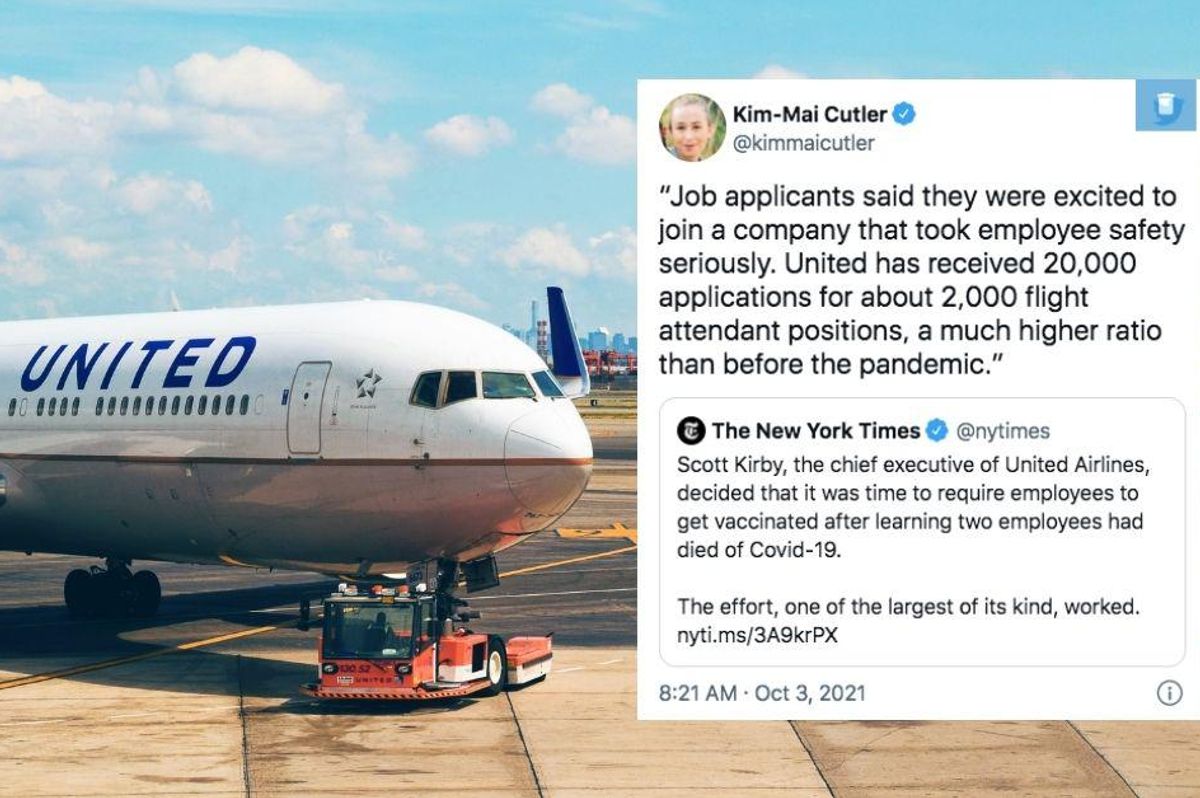Vaccine mandates work, most people support them, and it's maddening that we even need them at all

As debates over vaccine mandates raged this summer, United Airlines took the decisive step to require all employees to get vaccinated for COVID-19. Employees who applied and were approved for a medical or religious exemption would be placed on medical leave and risk losing income. Those who refused the vaccine and did not receive an exemption would be terminated.
The not-messing-around approach worked smashingly. Prior to the deadline, only a fraction of a percent of United's staff—320 out of 67,000 employees—ended up choosing termination. That left United Airlines with an astounding 99.5% vaccination rate.
United took a risk and it paid off. Not only did the company retain the vast majority of its workforce, but applicants started clamoring to work for the airline. According to The New York Times, the airline received 20,000 applications for approximately 2,000 flight attendant positions after the vaccine mandate was announced.
\u201cJob applicants said they were excited to join a company that took employee safety seriously. United has received 20,000 applications for about 2,000 flight attendant positions, a much higher ratio than before the pandemic.\u201dhttps://twitter.com/nytimes/status/1444631084721971208\u00a0\u2026— Kim-Mai Cutler (@Kim-Mai Cutler) 1633274504
United kicked off a trend. Other airlines followed suit, and we saw more and more companies requiring employees to be vaccinated.
Vaccine mandates have proven successful, but not without controversy. Within an already understaffed health care industry, the risk of losing employees who refuse to be vaccinated is real. So is the risk of unvaccinated health care workers treating patients.
In California, mandates for health care workers resulted in a huge uptick in vaccinations. The same thing happened in Texas. Despite predictions of a mass exodus of New York and New Jersey health care workers, only a small number chose to quit when mandates took effect. In fact, many of those who chose to stay on and take the alternative weekly testing option decided to get vaccinated after just a few weeks of being swabbed.
Mandates clearly work—but it's maddening that we have had to resort to them. Some success stories have proven that mandates aren't always necessary to reach a high vaccination rate. After being the only team in the NFL to have zero COVID-19 cases during last season, the Seattle Seahawks made a strong push to get their staff and players vaccinated. The NFL asked for teams to try for an 85% vaccination rate; with just one player declining, the Seahawks hit a whopping 99% vaccination rate weeks before the football season even began. By the time the season officially started, the NFL reported that 93% of players across the league had been vaccinated—a far higher percentage than the general population.
Perhaps that's due to the stringent protocols players who aren't vaccinated have to go through. Perhaps it's the sense of competition within the league and the knowledge that COVID-19 outbreaks can derail a team's chances of a winning season. Perhaps it's because NFL players are supportive of science and common sense than the average American. Whatever it is, the NFL has proven it's possible to create a culture that results in a high vaccination rate without mandates.
If only we could figure out how to create that culture in this country as a whole.
There are legitimate debates to be had about the government mandating vaccines (despite public schools having mandated vaccinations for more than a century), but it's harder to argue against private businesses and organizations requiring them as a condition of employment or participation. People sure do try, though. Anti-vaxxers and "freedom fighters" who disagree with all manner of mandates in the name of personal liberty are loud and proud in their stance. But that doesn't mean they're right.
According to Gallup, the majority of Americans support COVID-19 vaccine mandates. Other polls, including one from Fox News, have found the same thing. If mandates are going to help us stop losing tens of thousands of Americans every month, bring them on.
In a global pandemic that has taken the lives of more than 700,000 Americans in a year and a half, vaccines that lower the risk of infection and transmission and greatly lower the risk of hospitalization and death are a gift. Mandate or no mandate, getting vaccinated is objectively the right thing to do. It would be fabulous if we could get to a high vaccination rate without creating requirements, but with few exceptions (like the NFL), that ideal has proven to be unrealistic.
If it weren't for the massive misinformation machine derailing reality for millions, far fewer people would refuse the vaccine. We're battling a crisis of viral conspiracy theories in addition to the actual viral pandemic, and something has to give.
- A new study says low doses of the Pfizer vaccine are safe for kids as ... ›
- ICU doctor furious with unvaccinated patients: 'I cannot believe what ... ›
- Most COVID vaccine disinformation can be traced to just 12 people ... ›
- NFL quarterback Tommy DeVito lives with his mom - Upworthy ›







 Rihanna Nails GIF
Rihanna Nails GIF Stop Right There The End GIF by Freeform
Stop Right There The End GIF by Freeform